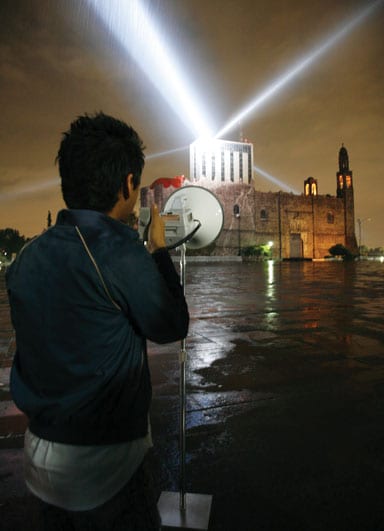
words Beatrice Galilee
In Trafalgar Square on a blustery Friday night in November, TV crews and cameraman are buzzing around artist Rafael Lozano-Hemmer, whose public art project Underscan, a joint commission between Tate, National Gallery and ICA, is captivating tourists, commuters and children alike. Huge scaffolds and lighting rigs are projecting bright white light across the forecourt of the National Gallery casting dark shadows from passers-by. People moving across the square have their movement monitored by high-tech sensors and, at a precise location, an image of one of 1,000 actors is projected into their shadows.
Lozano-Hemmer ambles over and waves happily and smiles at some kids who are attempting to pick the nose of their phantom shadow. The project is slightly in disarray, he admits, but he’s happy. “Often they act more like a kind of public fountain, they’re just there. Some people watch them, some don’t.”
This type of art – digital, ephemeral street furniture that can provoke strangers into sharing a smile or a raised eyebrow – is just part of what Lozano-Hemmer does. He’s interested in changing the way we use and perhaps the way we think about public space. “We’re producing experiences that interrupt normal narratives,” he says. “They are eccentricities, they are exceptions.” At the Barbican arts centre he currently has a small installation where one can pick up a radio signal by moving left or right – Classic FM in one spot and a taxi firm or ambulance service at another. As a receiver you somehow sense your role in the city.
Lozano-Hemmer grew up in Mexico and at the age of 12 moved to Spain. He studied chemistry at university in Vancouver, where he is now based, but gave up science for performance in search of excitement. After some false starts, including an “unsuccessful” performance in which he set himself on fire, he produced a piece called Surface Tension in 1991. Inspired by computer surveillance, it involved a giant eye that followed the movements of dancers. The public were unconvinced, so he removed the dancers, leaving the eye to follow the audience instead. This spectator involvement then became his “thing”.
Despite his techy-mechanical mind, Lozano-Hemmer’s work is a thoughtful response to the problems of public realm. He wants to bring back the idea of a stroll, a promenade, a place of contact or a place of connection. He is concerned about the generic globalised village and regeneration that only involves putting in some Victorian street lighting and a Starbucks. Often this is done with humour: in the case of Underscan, you are forced to make eye contact with a stranger nestling in your shadow, an experience that’s eerie, intimate and uncomfortable.
But his work also has the power to enfranchise people, as in another 2008 project in a square in Mexico City where 300 people had been killed in a peaceful demonstration in 1968. Lozano-Hemmer placed a megaphone, not unlike one used in the demonstrations, at one corner of the square and invited people to talk into it, projecting their words in beams of light. The result was a poetic and profound memorial in a city where free speech is often censored.
“I’m never going to make a sculpture of one guy and put it in a spot,” he says. “My projects are platforms, they’re like the pedestal for people to overtake the space. As such they’re projects that change over time, they’re projects that people can use to personalise their own space.”



















